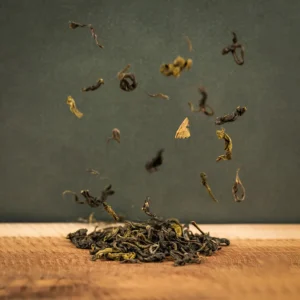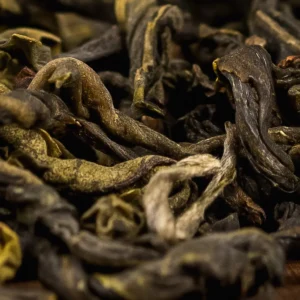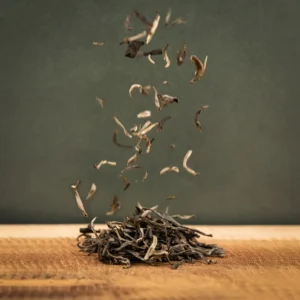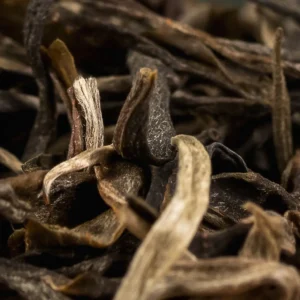Tea
-

 Select options This product has multiple variants. The options may be chosen on the product page
Select options This product has multiple variants. The options may be chosen on the product page -


Tiny Temple
From €12.00Select options This product has multiple variants. The options may be chosen on the product page
FAQ
Tea is a beverage made of the leaves of the Camellia sinensis plant, which is loved worldwide. In fact, it’s the second most consumed drink in the world, coming after water. What might come as a surprise to many is that all tea comes from the same plant.
It’s quite a wonder how the same plant can produce teas that taste so different: from brisk and refreshing green tea to malty and rich black tea. There are five main types of tea: black, green, white, oolong, and pu-erh.
Herbal “teas”, however, wouldn’t fall into the tea category, although we have come to call them that, and would more accurately be described as tisanes or herbal infusions.
Read more about tea in our blog.
How you brew your tea will largely depend on the type of tea and the brewing method you choose. While black teas, pu-erh, and many oolongs can withstand near-boiling temperatures of 90-95°C, green and white teas are much more delicate and require temperatures between 60-80°C.
Brewing green tea with boiling hot water might extract too many tannins, making the tea astringent and bitter. In contrast, brewing black tea with water that’s not hot enough might result in a brew with little flavor and depth. Steeping time, water temperature, and the tea-to-water ratio can often depend on personal preference.
Then we have cold brewing, which brings out sweeter, fruitier notes and is perfect for hot weather.
If you’re unsure about the brewing process, visit our website or the packaging for detailed tea guidance. Ultimately, we encourage everyone to experiment and discover the method that best suits their taste.
Learn more about how to brew a delicious cup of tea.
Tea originated in China as far back as 3000 years ago. While the processing and brewing methods were different at the time, there are records of tea cultivation in Southern China.
However, tea didn’t start spreading across China and establishing itself as a favored drink until the Tang Dynasty (618-906 AD). This was the time when the first and most influential tea book, Cha Jing (Classic of Tea) by Lu Yu, was published. The book comprehensively explores the cultivation, preparation, and cultural significance of tea in China, establishing the foundation for tea rituals and practices. From then on, tea became deeply embedded in Chinese culture, serving as a tribute, gift, trade commodity, and, of course, a beloved beverage for daily enjoyment.
It wasn’t until the early 19th century that merchants started to bring tea into India and cultivate it there. From then on, the drink spread across the world like wildfire. Today tea is most widely produced in China, India, Kenya, and Sri Lanka. While other countries like Japan, Taiwan, Myanmar, Nepal, and Malawi also have prominent tea industries of their own.
At Tea Kulture, sustainability and fair trade are at the heart of everything we do. We partner directly with farmers in the world’s prominent tea-producing regions who cultivate tea using natural, eco-friendly practices.
By ensuring fair wages and ethical working conditions, we support both the people and the planet. Our direct trade approach allows us to bring you premium-quality tea leaves while maintaining a commitment to fairness and environmental responsibility.
Read more about our story.
Each tea type is processed differently. In fact, it is the intricate process itself that gives the tea the same tea leaves such unique and distinct final profiles. Tea leaves plucked at the same time can either go on to become delicate and ethereal white teas or fermented, well-rounded pu-erh. This is where the skill of the tea craftsmen really comes through.
Albeit most teas do go through more or less the same steps before reaching their final form, which are:
• Harvesting: the leaves are plucked by the farmers.
• Withering: the plucked leaves release moisture, making them pliable.
• Rolling: this breaks down the cell walls and kickstarts the key oxidation process.
• Oxidation: the tea leaves are left to oxidize anywhere from a few minutes (green teas) to a few hours (black teas) in a space where humidity and temperature are carefully controlled.
• Drying: this final step preserves flavors and gets rid of any excess moisture, ensuring that the teas can last on our shelves for months or even years to come.
Read more about tea in our blog.
One of the most debated topics in the world of tea is its potential health benefits. Tea has long been associated with medicinal uses, particularly in traditional Chinese medicine.
Various teas have different benefits. For example, black tea is known for its warming qualities and promoting blood circulation, while green tea is cooling and pu-erh helps with metabolism. All teas are also known for their effects on the mind, particularly calming and clarifying. However, can tea really cure cancer, heart disease, or arthritis according to more modern claims? We approach these assertions with caution.
While it’s true that tea is rich in beneficial compounds — such as polyphenols (powerful antioxidants), L-theanine (a calming amino acid), and alkaloids (which have notable physiological effects) — scientific evidence linking tea directly to specific health cures remains inconclusive.
At Tea Kulture, we believe tea should be appreciated for its positive contributions to a healthy lifestyle, rather than viewed as a medicinal solution.
All tea made from the Camellia sinensis plant contains caffeine, though the amount is typically much lower than in coffee.
On average, a cup of tea provides between 15 and 60 mg of caffeine, while a cup of coffee contains approximately 95 mg.
However, the caffeine content of tea is not so straightforward and depends on a variety of factors. For example, the natural environment, use of fertilizers, the specific part of the plant harvested, seasonal variations, and, of course, the brewing time. Generally speaking, however, black tea does have the highest caffeine content, while white teas are known to have the lowest.
Read more about caffeine in tea.
Tea, made from the Camellia Sinensis plant, contains a moderate amount of caffeine, which may interfere with sleep if consumed later in the day. If you’re sensitive to caffeine, it’s wise to avoid drinking tea in the late afternoon or evening, as it might make falling asleep more difficult.
For a soothing, caffeine-free alternative, consider herbal infusions like chamomile or rooibos. These teas are naturally calming and promote relaxation without the stimulating effects of caffeine.
Properly storing tea is crucial to retain its freshness and flavor.
To preserve your tea leaves, place them in an airtight, opaque container to shield them from oxygen, which may lead to oxidation and compromise their aroma. Store your tea in a cool, dark location, away from sunlight and heat sources.
Ensure the storage area remains dry to prevent moisture absorption, which can degrade the tea’s quality. Avoid placing your tea near strong odors to prevent flavor contamination.
By investing in high-quality tea leaves and storing them correctly, you can prolong the retention of their intricate flavors for extended periods.
Read more on how to store loose-leaf tea.
Tea Kulture
© 2024 Tea Kulture | All Right Reserved
Payment Methods

